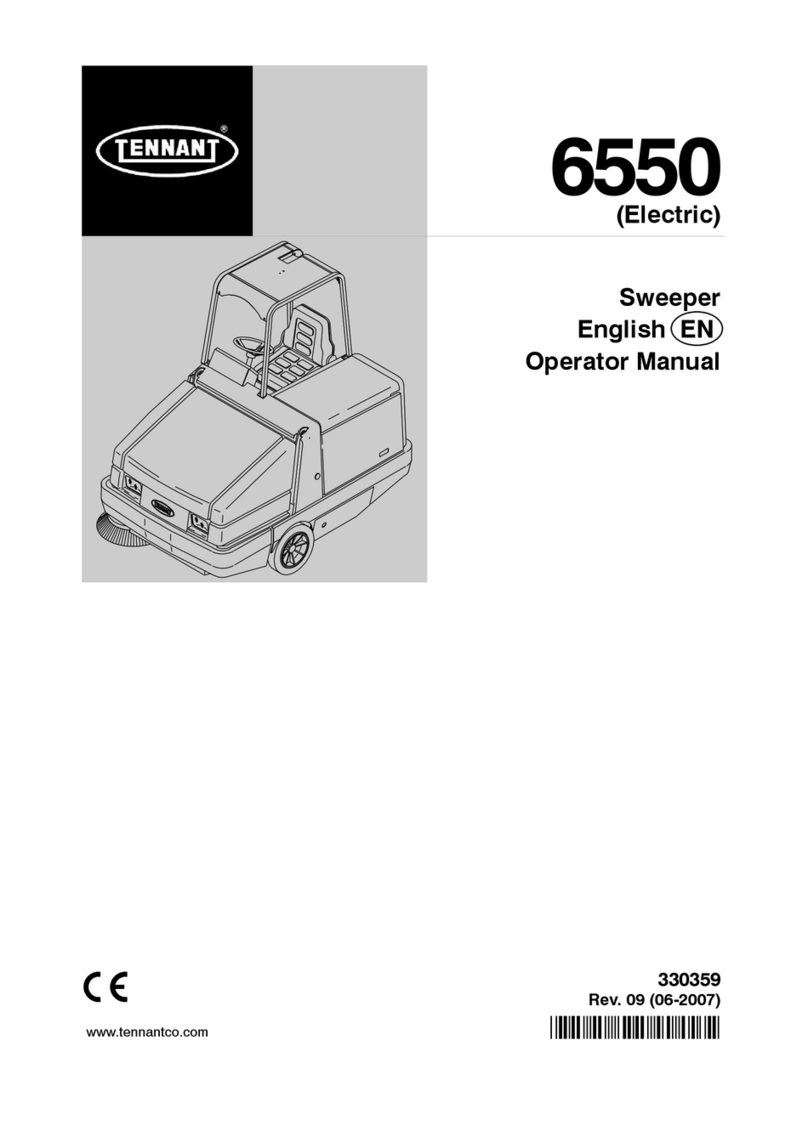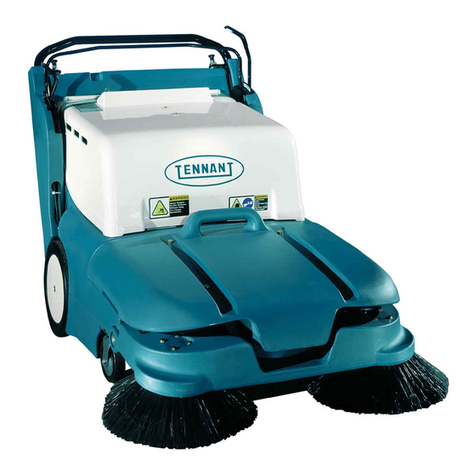
EN
while machine is moving.
-The machine must be stored only indoors.
-Do not allow the machine to be used as a toy.
-The machine is not designed for towing or
being towed.
-1HYHUUHVWREMHFWVRIDQ\VLJQL¿FDQWZHLJKWRQ
the machine, for whatever reason.
-Never obstruct the air inlet and release vents.
-Never remove, modify or circumvent safety
devices.
-During use, atomized spray may form. Inhaling
this atomized spray can be harmful to health.
-Work providers must conduct a risk
assessment in order to specify the necessary
protective measures relating to the formation
of atomized sprays, depending on the surface
being cleaned and the environment. Masks
with class FFP2 or equivalent or higher
protection are suitable for protecting against
the inhalation of atomized spray.
-Keep hands away from moving parts.
-In the case of malfunction and/or faulty
RSHUDWLRQ WXUQ WKH PDFKLQH Rႇ LPPHGLDWHO\
(disconnect from the batteries/mains power
supply) and do not tamper with it; contact a
service centre approved by the manufacturer.
-The machine is designed to operate in
temperatures between +4°C / 39.2°F and
+40°C / 104°F. It can be stored in temperatures
between +0°C / 32°F and +50°C / 122°F when
not in use.
-The machine is designed to operate at relative
humidity levels between 30% and 95%.
-The machine can operate at altitudes up to
2000 m / 6561.68 ft maximum.
-Use the brake to stop the machine.
-Do not use the machine to clean surfaces on
slopes or gradients steeper than indicated on
the data plate.
-Do not operate the machine on slopes or
gradients steeper than indicated on the data
plate.
-When using the machine on gentle gradients,
do not move transversely across the slope,
but keep the machine on a line parallel to the
direction of the incline, manoeuvring carefully
and without making U-turns.
-The machine must not be used by persons
(including children) with diminished physical,
sensory or mental capabilities, or lack of
experience and knowledge, unless they are
supervised by a person responsible for their
safety and have received instruction in the use
of the machine.
-Never use the machine to transport people or
goods or for towing.
-Do not wear jewellery, watches, ties or other
items.
-The operator must always use Personal
Protective Equipment: protective apron or
overalls, non-slip waterproof shoes, rubber
gloves, protective eyewear and ear defenders,
and mask for protection of the respiratory
airways.
Before leaving the machine or before maintenance:
-3DUNWKHPDFKLQHRQDÀDWOHYHOVXUIDFH
-7XUQRႇWKHPDFKLQHDQGUHPRYHWKHLJQLWLRQ
key.
-Apply the parking brake.
When performing maintenance:
-Alloperationsmustbecarriedoutinconditions
guaranteeing adequate visibility and lighting.
-Isolate the machine from its power source by
disconnecting the batteries.
-The operator must always use Personal
Protective Equipment: protective apron or
overalls, non-slip waterproof shoes, rubber
gloves, protective eyewear and ear defenders,
and mask for protection of the respiratory
airways.
-Do not wear jewellery, watches, ties or other
items.
-Do not push or tow the machine without an
operator sitting in the driving seat and able to
control the steering wheel.
-Protect the batteries from impurities such as
metal dust.
-Take care when handling battery acid, and
DYRLG FRQWDFW ,Q WKH HYHQW RI EDWWHU\ ÀXLG
OHDNDJHGRQRWWRXFKWKHÀXLGDQGREVHUYHWKH
following precautions: Contact with the skin
can cause irritation; wash with soap and water.
Inhalation of vapours can cause irritation
to the airways; stay out in the open air and
consult a doctor. Contact with the eyes can
cause irritation; wash the eyes immediately,
ÀRRGLQJZLWKZDWHUIRUDWOHDVWPLQXWHVDQG
consult a doctor.
-Never rest tools on the batteries as they could
cause short circuits leading to explosions.
-Always use the battery charger accompanying
the machine (if supplied), or if not, a product
ZLWK VSHFL¿FDWLRQV DV UHFRPPHQGHG LQ WKH
technical data.
-Installation of the battery should be entrusted
to a TENNANT approved service technician.
-Inspect the power cable of the battery charger
periodically to ensure that it is not damaged;
in the event of damage being discovered, the
appliance cannot be used. Replacement of
the cable should be entrusted to a TENNANT
approved service technician. Detach both
connections of the battery charger (AC side
and DC side).
-Do not tug at the battery charger cable to
disconnect it from the socket: grip the plug
4



















































